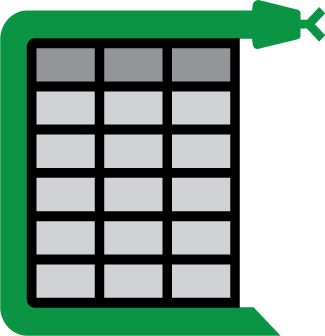Camelot: PDF Table Extraction for Humans¶
Release v0.11.0. (Installation)






Camelot is a Python library that can help you extract tables from PDFs!
Note
You can also check out Excalibur, the web interface to Camelot!
Here’s how you can extract tables from PDFs. You can check out the PDF used in this example here.
>>> import camelot
>>> tables = camelot.read_pdf('foo.pdf')
>>> tables
<TableList n=1>
>>> tables.export('foo.csv', f='csv', compress=True) # json, excel, html, markdown, sqlite
>>> tables[0]
<Table shape=(7, 7)>
>>> tables[0].parsing_report
{
'accuracy': 99.02,
'whitespace': 12.24,
'order': 1,
'page': 1
}
>>> tables[0].to_csv('foo.csv') # to_json, to_excel, to_html, to_markdown, to_sqlite
>>> tables[0].df # get a pandas DataFrame!
Cycle Name |
KI (1/km) |
Distance (mi) |
Percent Fuel Savings |
|||
Improved Speed |
Decreased Accel |
Eliminate Stops |
Decreased Idle |
|||
2012_2 |
3.30 |
1.3 |
5.9% |
9.5% |
29.2% |
17.4% |
2145_1 |
0.68 |
11.2 |
2.4% |
0.1% |
9.5% |
2.7% |
4234_1 |
0.59 |
58.7 |
8.5% |
1.3% |
8.5% |
3.3% |
2032_2 |
0.17 |
57.8 |
21.7% |
0.3% |
2.7% |
1.2% |
4171_1 |
0.07 |
173.9 |
58.1% |
1.6% |
2.1% |
0.5% |
Camelot also comes packaged with a command-line interface!
Note
Camelot only works with text-based PDFs and not scanned documents. (As Tabula explains, “If you can click and drag to select text in your table in a PDF viewer, then your PDF is text-based”.)
You can check out some frequently asked questions here.
Why Camelot?¶
Configurability: Camelot gives you control over the table extraction process with tweakable settings.
Metrics: You can discard bad tables based on metrics like accuracy and whitespace, without having to manually look at each table.
Output: Each table is extracted into a pandas DataFrame, which seamlessly integrates into ETL and data analysis workflows. You can also export tables to multiple formats, which include CSV, JSON, Excel, HTML, Markdown, and Sqlite.
Support the development¶
If Camelot has helped you, please consider supporting its development with a one-time or monthly donation on OpenCollective!
The User Guide¶
This part of the documentation begins with some background information about why Camelot was created, takes you through some implementation details, and then focuses on step-by-step instructions for getting the most out of Camelot.
- Introduction
- Installation of dependencies
- Installation of Camelot
- How It Works
- Quickstart
- Advanced Usage
- Process background lines
- Visual debugging
- Specify table areas
- Specify table regions
- Specify column separators
- Split text along separators
- Flag superscripts and subscripts
- Strip characters from text
- Improve guessed table areas
- Improve guessed table rows
- Detect short lines
- Shift text in spanning cells
- Copy text in spanning cells
- Tweak layout generation
- Use alternate image conversion backends
- Frequently Asked Questions
- Command-Line Interface
The API Documentation/Guide¶
If you are looking for information on a specific function, class, or method, this part of the documentation is for you.
The Contributor Guide¶
If you want to contribute to the project, this part of the documentation is for you.

